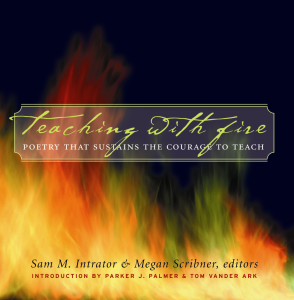From: Teaching with Fire
— Maggie Anderson
 Coming from Montana, I have learned the art of fire building. I have tried different types of wood, different sizes of kindling, different ways of laying the logs. I used to pile the wood on, to no avail. Hard as I tried to fan the flames into existence, they would only smolder. But now, after years of practice, most times I can build a fire to warm our home.
Coming from Montana, I have learned the art of fire building. I have tried different types of wood, different sizes of kindling, different ways of laying the logs. I used to pile the wood on, to no avail. Hard as I tried to fan the flames into existence, they would only smolder. But now, after years of practice, most times I can build a fire to warm our home.
So it is with teaching. After five years my “fire” was burning brightly. I thrived on the energy that ignites in a classroom. But I was exhausted at the end of the day and overwhelmed by the never-ending list of things to do for my work, my home, my family. After much soul-searching, I realized I was piling on too many logs too tightly and the flame inside me was beginning to wane— even smolder at times. I was desperate for some “space.”
Children need space as well. The constant piling on of facts and figures, the demands of time and energy can quickly douse the flame—the energy that children bring to the classroom.
I am learning, for myself and for my students, to choose consciously the logs I place on my own fire, and to pay special attention to the spaces that invite reflection and warmth. Given this space between the logs, my students and I often witness the special beauty that ignites and takes on a life of its own.
—Maggie Anderson
Middle and High School Science Teacher
Montana
 Maggie Anderson taught biology, life and earth sciences to seventh through tenth graders for fifteen years. She recently shifted her focus to community-level education around youth substance use prevention and works to build systems of support aimed at creating a safe and healthy community where youth and families can thrive.
Maggie Anderson taught biology, life and earth sciences to seventh through tenth graders for fifteen years. She recently shifted her focus to community-level education around youth substance use prevention and works to build systems of support aimed at creating a safe and healthy community where youth and families can thrive.
Fire
What makes a fire burn
is space between the logs,
a breathing space.
Too much of a good thing,
too many logs
packed in too tight
can douse the flames
almost as surely
as a pail of water would.
So building fires
requires attention
to the spaces in between,
as much as to the wood.
When we are able to build
open spaces
in the same way
we have learned
to pile on the logs,
then we can come to see how
it is fuel, and absence of the fuel
together, that make fire possible.
We only need to lay a log
lightly from time to time.
A fire
grows
simply because the space is there,
with openings
in which the flame
that knows just how it wants to burn
can find its way.
—Judy Sorum Brown






Leave a Comment